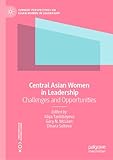Central asian women in leadership: challenges and opportunities
Material type: TextSeries: Current Perspectives on Asian Women in LeadershipPublication details: Cham Springer 2025Description: xv, 190 pISBN:
TextSeries: Current Perspectives on Asian Women in LeadershipPublication details: Cham Springer 2025Description: xv, 190 pISBN: - 9783031819490
- 658.4092 TAN
| Item type | Current library | Collection | Call number | Copy number | Status | Date due | Barcode | |
|---|---|---|---|---|---|---|---|---|
 Book
Book
|
Indian Institute of Management LRC General Stacks | Human Resource and Organization Behvaiour | 658.4092 TAN (Browse shelf(Opens below)) | 1 | Available | 009190 |
Table of contents:
Front Matter
Pages i-xv
Download chapter PDF
Empowered Voices: Celebrating Women’s Leadership Across Central Asia’s Five Republics
Gary N. McLean
Pages 1-8
Women in Leadership in the Kyrgyz Republic
Baktygul Shabdan, Lana V. Kulik, Elira Turdubaeva
Pages 9-31
Current Status of Women in Public Administration Leadership in Kazakhstan
Azhar Baisakalova, Aliya Tankibayeva
Pages 33-60
Media Framing of Women in Leadership Positions: A Case Study of Kazakhstan
Ainur Slamgazhy, Almabek Ibraiymov, Zarina Buyenbayeva
Pages 61-86
Women’s Leadership in Science in Uzbekistan
Zulfiya Kannazarova, Dilrabo Muqumova, Mukhiddin Norkobilov, Alisher Jumanov, Aliya Tankibayeva
Pages 87-109
Basin Women’s Forum of Tajik part of Syr-Darya River. Strengthening Women’s Leadership in Water Management
Khayrinisso Rasulova, Aliya Tankibayeva
Pages 111-133
Youth in STEM: Women’s Contribution to the Innovation Ecosystem in Kazakhstan
Aliya Tankibayeva
Pages 135-159
Perspectives on the Role of Women in Future Civil Societies in Central Asia
Anastassiya V. Lipovka, Maigul Nugmanova
Pages 161-190
[https://link.springer.com/book/10.1007/978-3-031-81950-6]
This volume examines the unique cultural and socioeconomic aspects of Central Asia and the effects of these elements on women leaders in the region, focusing on five countries. Unfortunately, gender inequality and underutilization of women’s talents are deeply embedded in historical, socio-economic, and cultural developments of this region. Nevertheless, despite the difficulties Central Asian women leaders face, there are emerging patterns of changes and improvement in the current state of women. This book discusses the impact of these changes.
The book opens with an overview chapter that covers the historical and socio-cultural background for the region, followed by five chapters devoted to each Central Asian country. Next, there are chapters discussing leadership opportunities for women, in business as well as education and government. The closing chapter identifies commonalities and differences among countries in the region and offers a future avenues of research.
This edited book has critical implications for the development of women leaders in Central Asia, providing insights that explain the background, current tendencies, and future opportunities for developing the potential of highly qualified women leaders in the Central Asian countries.
(https://link.springer.com/book/10.1007/978-3-031-81950-6)
There are no comments on this title.

